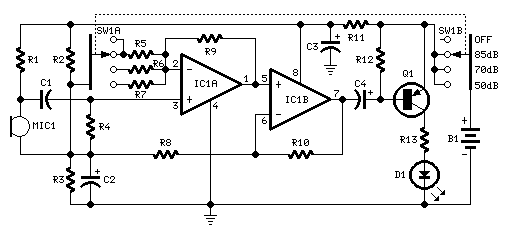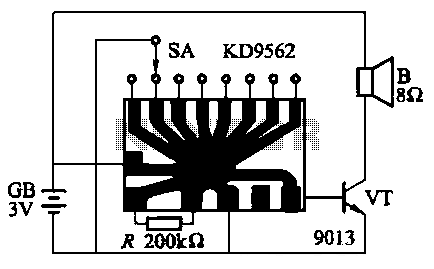
Room Noise Detector Schematic Circuit

This circuit is designed to signal the exceeding of a fixed threshold in room noise through a flashing LED. Three fixed levels are selectable: 50, 70, and 85 dB. Two operational amplifiers provide the necessary gain for sounds captured by a miniature electret microphone to drive the LED. The circuit is powered off when switch SW1 is in the first position. The second, third, and fourth positions power the circuit and set the input sensitivity threshold to 85, 70, and 50 dB, respectively. The circuit draws 1 mA with the LED off and 12-15 mA when the LED is consistently illuminated. The 50 dB setting is specifically intended for monitoring noise levels in a bedroom at night. If the LED remains steadily on or flashes brightly frequently, it indicates that the bedroom environment is too noisy for restful sleep.
This circuit employs a miniature electret microphone that captures ambient sound levels, which are then amplified using two operational amplifiers (op-amps) configured in a non-inverting configuration. The gain of the op-amps can be adjusted to ensure that the output signal is sufficient to drive the LED indicator effectively.
The switch SW1 serves as a multi-position selector that not only powers the circuit but also allows the user to choose the desired noise threshold level. The first position of the switch turns off the circuit, while the subsequent positions correspond to the different dB thresholds. Each threshold is calibrated to trigger the LED based on the ambient noise levels detected by the microphone.
When the ambient noise exceeds the selected threshold, the op-amps output a signal strong enough to activate the LED. The LED will flash in response to the noise level, providing a visual indication of excessive noise. The current consumption of the circuit is optimized for low power when the LED is off, drawing only 1 mA, while the current increases to 12-15 mA when the LED is illuminated, ensuring that the circuit remains efficient while providing adequate feedback to the user.
The choice of the 50 dB threshold is particularly significant for nighttime monitoring, as it allows individuals to assess whether their sleeping environment is conducive to rest. A steady or frequently flashing LED indicates that the noise levels are too high, prompting the need for corrective measures to enhance sleep quality.
In summary, this circuit serves as a practical tool for monitoring ambient noise levels, utilizing an electret microphone, op-amps, and an LED to provide immediate feedback on the acoustic environment.This circuit is intended to signal, through a flashing LED, the exceeding of a fixed threshold in room noise, chosen from three fixed levels, namely 50, 70 & 85 dB. Two Op-amps provide the necessary circuit gain for sounds picked-up by a miniature electret microphone to drive a LED.
With SW1 in the first position the circuit is off. Second, third and fourth positions power the circuit and set the input sensitivity threshold to 85, 70 & 50 dB respectively. Current drawing is 1mA with LED off and 12-15mA when the LED is steady on. The 50 dB setting is provided to monitor the noise in the bedroom at night. If the LED is steady on, or flashes bright often, then your bedroom is inadequate and too noisy for sleep.
🔗 External reference
This circuit employs a miniature electret microphone that captures ambient sound levels, which are then amplified using two operational amplifiers (op-amps) configured in a non-inverting configuration. The gain of the op-amps can be adjusted to ensure that the output signal is sufficient to drive the LED indicator effectively.
The switch SW1 serves as a multi-position selector that not only powers the circuit but also allows the user to choose the desired noise threshold level. The first position of the switch turns off the circuit, while the subsequent positions correspond to the different dB thresholds. Each threshold is calibrated to trigger the LED based on the ambient noise levels detected by the microphone.
When the ambient noise exceeds the selected threshold, the op-amps output a signal strong enough to activate the LED. The LED will flash in response to the noise level, providing a visual indication of excessive noise. The current consumption of the circuit is optimized for low power when the LED is off, drawing only 1 mA, while the current increases to 12-15 mA when the LED is illuminated, ensuring that the circuit remains efficient while providing adequate feedback to the user.
The choice of the 50 dB threshold is particularly significant for nighttime monitoring, as it allows individuals to assess whether their sleeping environment is conducive to rest. A steady or frequently flashing LED indicates that the noise levels are too high, prompting the need for corrective measures to enhance sleep quality.
In summary, this circuit serves as a practical tool for monitoring ambient noise levels, utilizing an electret microphone, op-amps, and an LED to provide immediate feedback on the acoustic environment.This circuit is intended to signal, through a flashing LED, the exceeding of a fixed threshold in room noise, chosen from three fixed levels, namely 50, 70 & 85 dB. Two Op-amps provide the necessary circuit gain for sounds picked-up by a miniature electret microphone to drive a LED.
With SW1 in the first position the circuit is off. Second, third and fourth positions power the circuit and set the input sensitivity threshold to 85, 70 & 50 dB respectively. Current drawing is 1mA with LED off and 12-15mA when the LED is steady on. The 50 dB setting is provided to monitor the noise in the bedroom at night. If the LED is steady on, or flashes bright often, then your bedroom is inadequate and too noisy for sleep.
🔗 External reference
Warning: include(partials/cookie-banner.php): Failed to open stream: Permission denied in /var/www/html/nextgr/view-circuit.php on line 713
Warning: include(): Failed opening 'partials/cookie-banner.php' for inclusion (include_path='.:/usr/share/php') in /var/www/html/nextgr/view-circuit.php on line 713





